Paper Menu >>
Journal Menu >>
 Advances in Pure Mathematics, 2011, 1, 325-333 doi:10.4236/apm.2011.16059 Published Online November 2011 (http://www.SciRP.org/journal/apm) Copyright © 2011 SciRes. APM Toeplitz and Translation Operators on the q-Fock Spaces* Fethi Soltani Higher College of Technology an d Informatics, Tunis, Tunisia E-mail: fethisoltani10@yahoo.com Received June 25, 2011; revised July 12, 2011; accepted July 28, 2011 Abstract In this work, we introduce a class of Hilbert spaces of entire functions on the disk q 1 ,1 Do q , , with reproducing kernel given by the q-exponential function 0< <1q q ez; and we prove some proper- ties concerning Toeplitz operators on this space. The definition and properties of the space extend naturally those of the well-known classical Fock space. Next, we study the multiplication operator by and the q-Derivative operator q Q z q D on the Fock space ; and we prove that these operators are ad- joint-operators and continuous from this space into itself. Lastly, we study a generalized translation operators and a Weyl commutation relations on . q q Keywords: q-Fock Spaces, q-Exponential Function, q-Derivative Operator, q-Translation Operators, q-Toeplitz Operators, q-Weyl Commutation Relations 1. Introduction In 1961, Bargmann [1] introduced a Hilbert space of entire functions =0 =n n n f za z on such that 22 =0 :=! <. n n fan On this space the author study the differential operator =d dDz and the multiplication operator by , and proves that these operators are densely defined, closed and adjoint-operators on (see [1]). Next, the Hilbert space is called Segal-Bargmann space or Fock space and it was the aim of many works [2,3]. z In this paper, we consider the q-exponential function: =0 1 := , ; n n qnn q ez z qq where 11 =0 ;:=1,=1,2,,. ni ni qqq n We discuss some properties of a class of Fock spaces associated to the q-exponential function and we give some applications. In the first part of this work, building on the ideas of Bargmann [1], we define the q-Fock space q as the space of entire functions =0 =n n n f za z on the disk 1 ,1 Do q of center oand radius 1 1d such that q, an 2 2 =0 ; :=< . 1 n nn qn qq fa q f and g Let be in, such that q =n n=0 n f zaz and =0 =n n n g zbz , the inner pro- duct is given by =0 ; ,= 1 n nn n qn qq fgab q . The q-Fock space has also a reproducing kernel q q given by 1 ,=;,, 1 qq wzewzwzD oq . *Author partially supported by DGRST project 04/UR/15-02 and CMCU program 10G 1503. 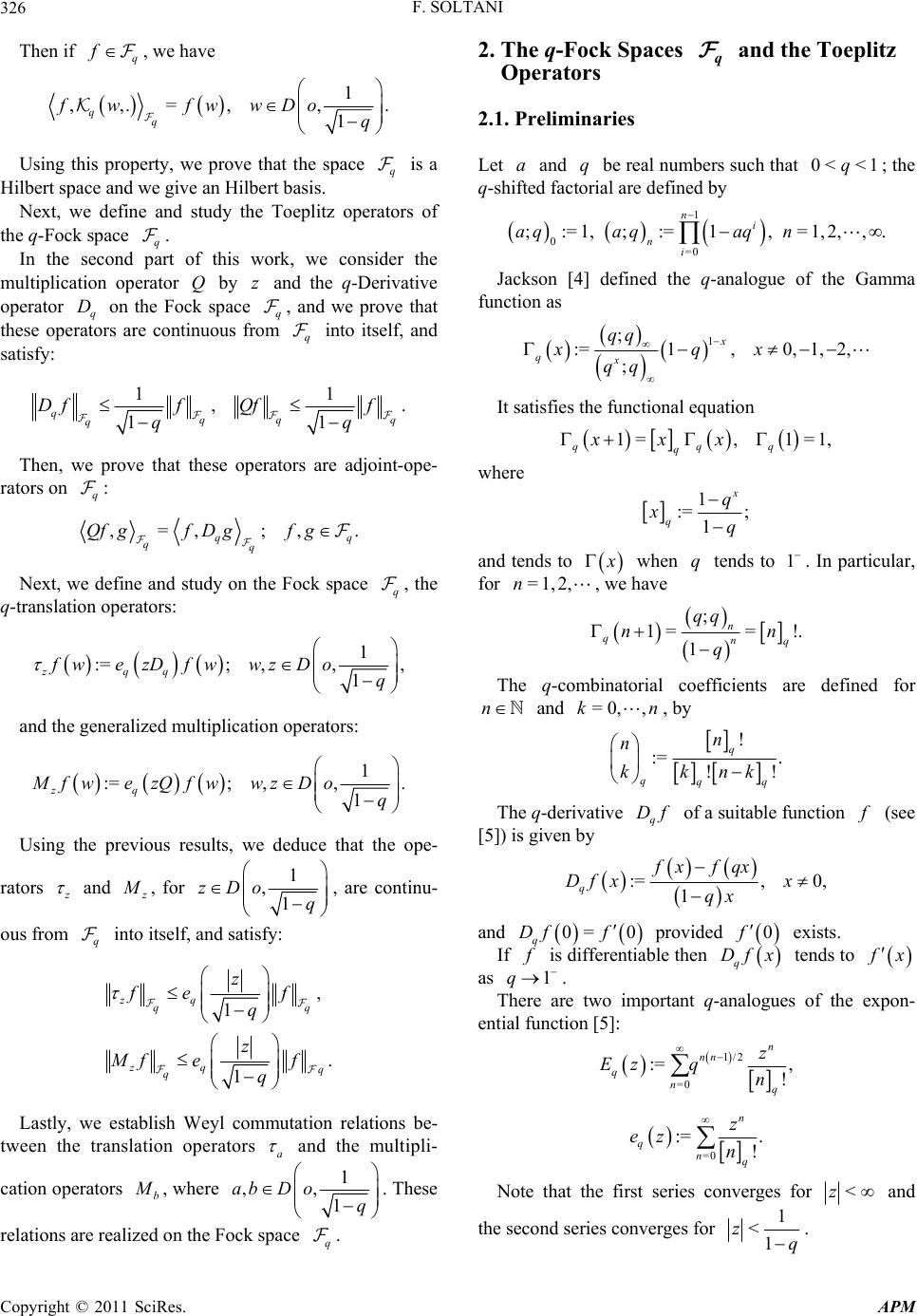 F. SOLTANI 326 Then if , we have q f 1 ,,.= ,, 1 q.fw fwwDoq Using this property, we prove that the space is a Hilbert space and we give an Hilbert basis. Next, we define and study the Toeplitz operators of th nsider the m he Focpaceand we prove that th q q e q-Fock space q . In the second part of this work, we co ultiplication operator Q by z and the q-Derivative operator q D on tk s q , ese operators are continuous from q into itself, and satisfy: 11 ,. q Dff Qff 11 qq q qqq Then, we prove that these operators are adjoint-ope- rators on : q ,=,;, . qq qq Qf gf Dgf g Next, we define and study on the Fock space , the q-translation operators: q 1 :=; ,,, zqq fwezDfwwzDo 1q and the generalized multiplication operators: 1 :=; ,,. 1 zq Mfwe zQfwwzDo q Using the previous results, we deduce that the ope- rators z and z M , for 1 ,1 zDoq from into itself, and satisfy: , are continu- ous q , 1 zq q fe f q . 1 q zq q q z z Mf ef q Lastly, we establish Weyl commutation relations be- tween the translation operators a and the multipli- cation operators b M , where 1 ,, 1 abD oq . These relations are realized on the Fock s pace 2. The q-Fock Spaces and the Toeplitz Le e real numbers such that ; the -shifted factorial are defined by alogue of the Gamma function as q . q Operators 2.1. Preliminaries t a and q b0< <1q q 1 0 ;:=1, ;:=1, =1,2,,. ni n aqaqaq n =0i Jackson [4] defined the q-an 1 ; :=1,0, 1, 2, ; qx qq It satisfies th x qq xqx e functional equation 1=, 1=1, qqq q xxx where 1 := ; 1 x qq q x and tends to x , we have when tends to. In particular, for q 1 =1,2,n ; 1== !. 1 n qnq q Tbinatorial qq nn he q-comcoefficients are defined for n and , by =0,,kn ! := . !! qqq kkn k q-derivati of a s q n n The ve uitable function q Df f (see [5]) is given by :=, 0, 1 qqx and fx fqx Df xx 0 q0=Df f provided exists. If 0f f is differentiable then tends to Df x q f x as 1q There . two important qs of the e l function [5]: are-analoguexpon- entia 1/2 =0 ! qnq n := , n z Ez q nn =0 := . ! n qnq z ez n Note that the first series converges for <z and the second series converges for 1 <1 zq. Copyright © 2011 SciRes. APM  F. SOLTANI327 gral rTherefore the function q has the q-inteepre- sentation [6]: 1 1 1 0 =d,>0, q qq q xr qrrx (1) where the q-integ xE ral (introduced by Jackson [4]) is defined by Lemma 1. The function 0=0 d=1 . qn fx xqaqfaq ann . q e , 1 ,1 Do q , is the unique analytic solution of the q-problem: 1. he form Replacing in (2ain = q Dyzy (2) ,0=yz Proof. Searching a solution of (2) in t =n yz az . Then =0 n n =1 =. qn q n Dyza nz ), we obt 1n 1 =1 =1 =. nn nn q nn anz ax Thus, 1 =,=1,2, nn q anan We deduce that 1 =. nn q aa n We get =. ! n n q an Therefore, =0 == ! n q nq z yze z n , which completes the proof of the lemma. □ 2.2. The q-Fock Spaces e denote by q W 1 ,1 HDo q the space of entire functions on 1 ,1 Do q efined on . the measure d q m 1 ,1 Do q by 1 :=,=e. 2π i qqq dmzEqrdzrrd 21 ,, 1q LDo m q functions the space of measurable f on 1 ,Do satisfying 1q 2 2 1 , 1 2,, := < q Do LDom ffzdmz 1 1 . q q q Definition 1. We define the prehilbertian space to be the space of functions in q, 2 11 ,,, 1q 1 H DoL Dom q , equippe q d with the inner product 1 ,1 ,= qq Do q , f gfzgzd mz and the norm 1/2 2 1 ,1 =. q f q Do q fzdmz Remark 1. If 1q ’s space , the space agrees with the Segal-Bargmann (see [1]). Proposi t ion 1. 1) For all such that q q =0 =n n n f f zaz ve we ha, 22 =0 =!. qn fa nq n (3) 2) For all ,q fg =0 =n n n f zaz such that and ==0 n n n g zbz , we have =0 ,= qn fg !. nn q abn (4) 3) For ,q fg , we have ,=0, = qq. f gfDggzgz Proof. Given and ed convergence theoremave =0 =n nq n fz az n nq z. =0 =n gz b 1) By dominat’s, we h 2 1 , ,=0 1 qmn q Do mn q =. n m aazzdm z f Copyright © 2011 SciRes. APM 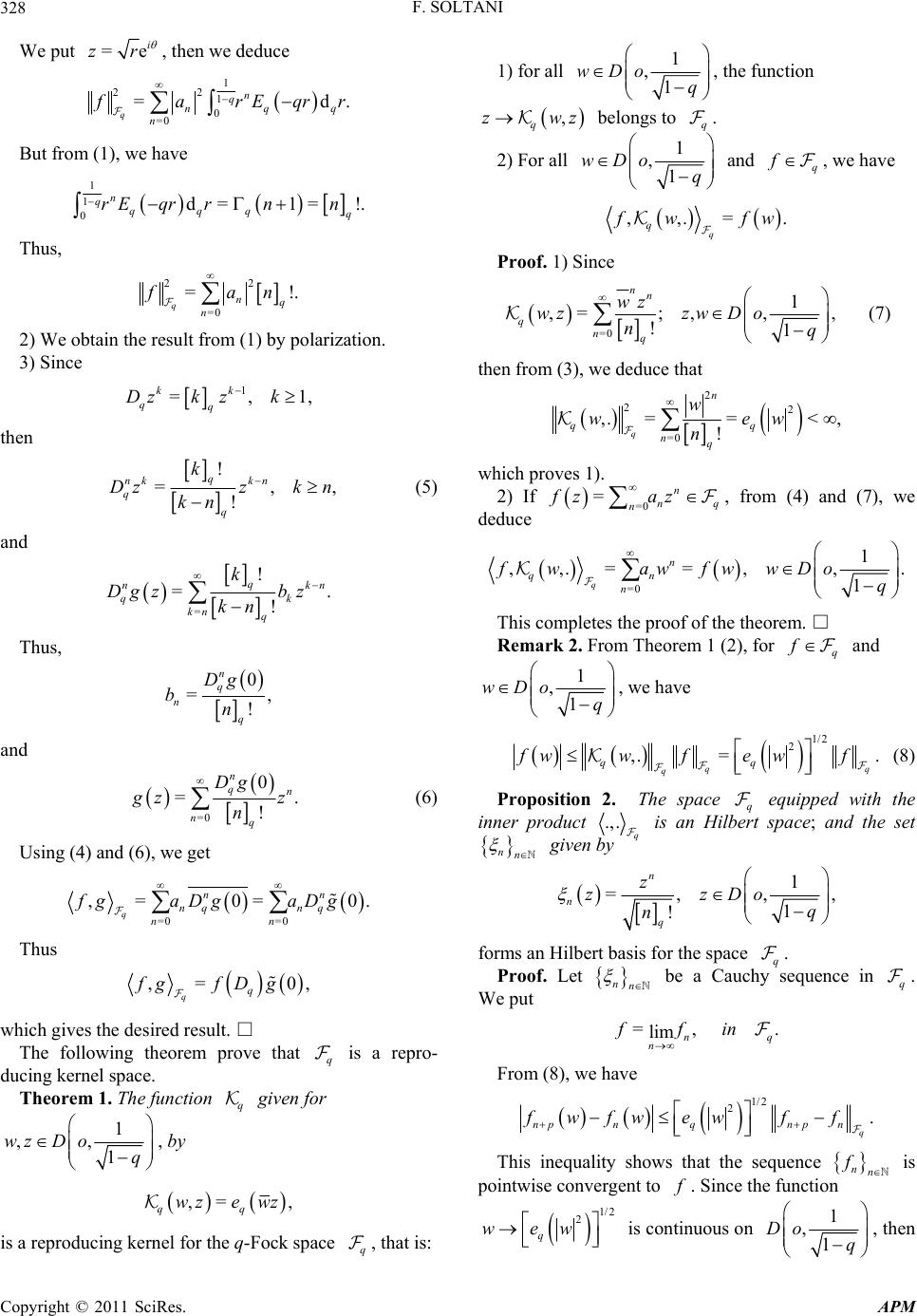 F. SOLTANI 328 We put =e i zr , then we deduce 1 221 0 =0 nq =d. q n qq n f arEqr r But from (1), we have 1 1 0d= qq rE qr 1= !. n qqq r nn Thus, 22 =0 =! qnq n fan . 2) We obtain the result from (1) by polarization. 3) Since 1 =,1, kk qq Dzk zk then ! =, ! q nk kn q q k Dzzk n kn , (5) and = ! =. ! q n qk kn q k Dgz bz kn k n Thus, 0 =, ! n q n q Dg bn and =0 0 =. ! n qn nq Dg g zz n (6) Using (4) and (6), we get =0 qnq n =0 ,=0= 0. nn nq n fg aDgaDg Thus ,= 0 qq fgfD g , whi the desired result. □ The following theorem prove that is a repro- ducing kernel space. iven for ch gives q Theorem 1. The function g q 1 ,,wzD o , b 1q y ,= q wz , q e wz is a reproducing kernel for the q-Fock space , that is: 1) for all q 1 ,1q wDo , the function ,zw qz belongs to 2) For all q . 1 ,1 wDo q and, we have q f = ,,. . q q f wf Proof. 1) Since w =0 ,= qn wz n 1 ; ,,, !1 nn q wz zwD oq (7) then from (3), we deduce that 2 22 =< , n q ww which proves 1). 2) If , from (4) and7), we deduce =0 ,. =! q q nq we n =0 =n nq n fz az ( =0 , .==1 q n n awf q This completes the proof of the theorem. □ Remark 2 . From Theorem 1 (2), for and 1 ,,, . qn fw wwDo q f 1 ,Do , we have 1q w 1/2 2 = . q qq fwe wf (8) Proposition 2. The space equipped with the inner product ,. qq w f q .,. q is anace; and th Hilbert spe set nn given by 1 =,, , n nz zzDo 1 ! qq n forms an Hilbert basis for the space Proof. Let q . nn be a Caucequence in We put ), we have hy s q . =, l ffin . im nq n From (8 1/2 2. q npnqnp n fwfw ewff nn f This inequality shows that the sequence is pointwise convergent to . Since the function f 1/2 2 q ew 1 ,1 Do q hen w is continuous on , t Copyright © 2011 SciRes. APM  F. SOLTANI329 converge compact of nn fs to f uniformly on allset 1 ,1q . Consently, f is an entire Do que ction on fun1 ,1q , then belongs to theDo space er hand, fromti f q On the oth the relaon (4), we get . , ,= q nm nm , where ,nm is show is the Kronecker symbol. Ths that the family nn is an orthonormal set in q . Let =n az be an eleme =0 n n fz nt of q such that ,=0, . q n fn From the relation (4), we deduce that 2.3. Toepliz Operators on this paragraph we study the Toeplitz operators on cla sical Toeplitz op rs [2]. =0,. n an This completes the proof. □ q In q . era- These operators generalize thes to First we define the orthogonal projection operator from P 21 L ,, Do m 1q q into , by q 1 2 ,. LD m q ,, 1 := ,, 1 ,, 1 qoq PfwfKw wDo q where q K finiti is the reproducing kernel given by (7). Deon 2. Let be a measurable function on 1 , Do . The Toeplitz operator T 1q is the operator given by := ,TfP f for every 21 :=:, , 1 qq fDT f fLDom q . Remark 3 . Let 1 ,1 LDo q . 1) The operator is bounded and T . T 2) By derivation a under the integral signnd using (2), we have = z q TD. Theorem 2. If 1 ,1 LDo q hen has compact support, tT is a compact operator. Proof. For 1 ,1 LDo q have , we 1 2,, 1 1 ,1 , =d nk LDo m q q nk q Do q T Tw wmw . Since 1 ,1 =, n nq q Do q Tw zzKwzmz d. Applying Fubini's theorem and Theorem 1, we obtain 1 2,, 1 1 2 =, . nk ,, 1 , nk LDo m q q LDo m q q T Thus, 2 1 2,, ,=0 1 2 1 2,, ,=0 1 , =, nk LDo m q nk q nk LDo m q nk q T . Since 1 ,1 LDo q with compact support, there are positive constants and a K so that ,..zK z =0, ae and for all >za . Then for ,nk , we get 1 2, , 1 =d nk LDo q , 1 || . !! m q k nq za qq zzz mz nk Thus, Copyright © 2011 SciRes. APM 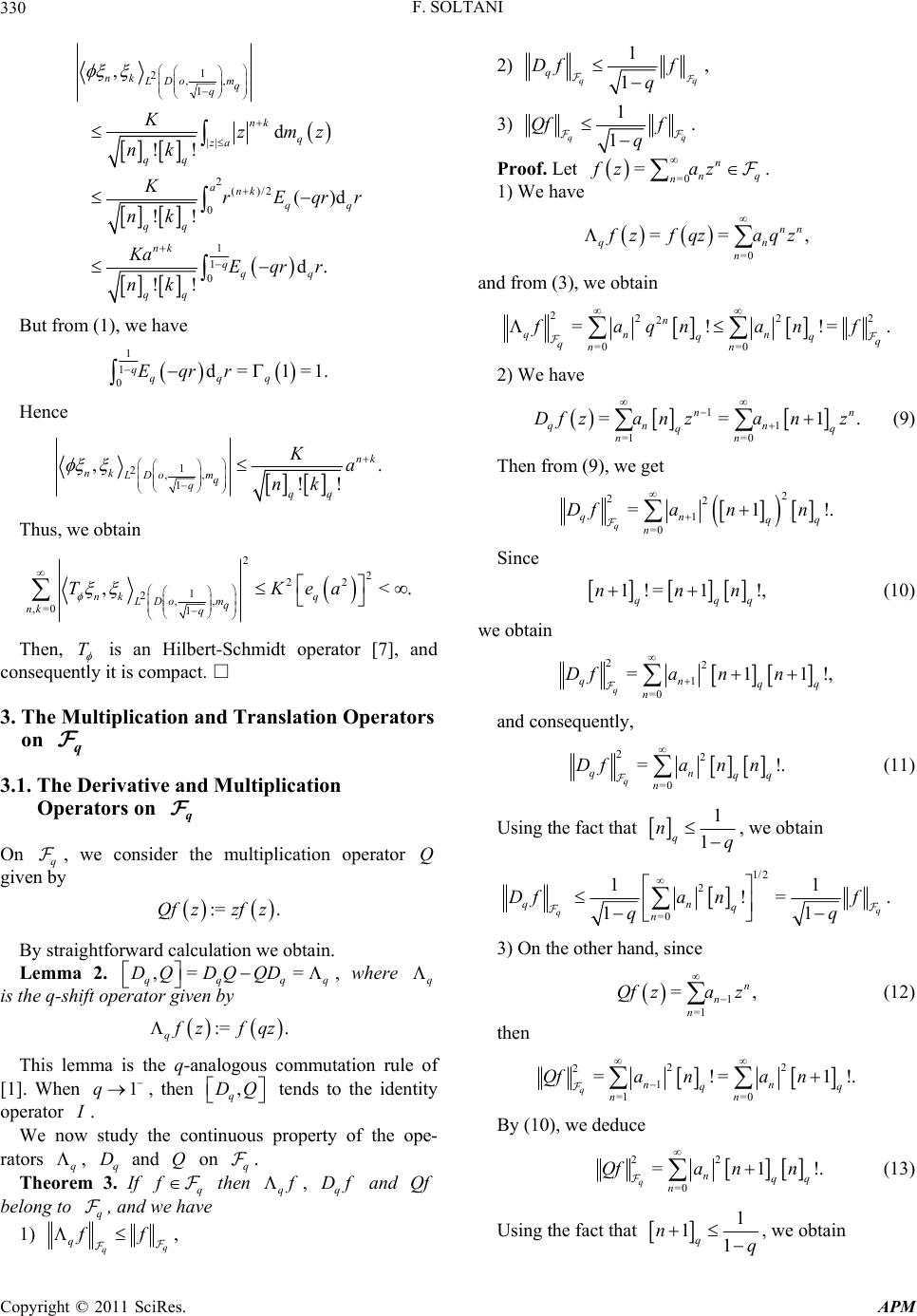 F. SOLTANI 330 1 2,, 1 || 2()/2 0 1 1 0 , d !! ()d !! d. !! nk LDo m q q nk q za qq ank qq qq nk qqq qq Kzmz nk KrEqr nk Ka Eqrr nk r But from (1), we have 1 1 0d= 1=1. qqqq Eqrr Hence 1 2,, 1 ,. nk LD oq !! nk m qqq Ka nk Thus, we obtain 2 2 22 1 2,, ,=0 1 ,< nk q LDo m q nk q TKe .a Then, T is an Hilbert-Schmidt operator [7], and consequepact. □ 3. The Multiplication and Translation Operators on 3.1. The Derivative and Multiplication n , we consider the multiplication operator Lq ntly it is com q Operators on q Oq given by Q := .Qf zzf z By straightforward calculation we obtain. emma 2. ,DQ D = = qqq QQD , where q is thift operator given by e q-sh := . q f zfqz This lemma is the q-analogous cmmutation rule of [1]. When , then tends to the identity op o 1q ,DQ q erator I . We now study the continuousy of the ope rators q , q D and Q on q propert- . If th Theorem 3. q fen q f , and bel q Df Qf ong to q , and we have 1) q q 2) 1 1 qq q Df f q , 3) 1 1 Qf q . qq f of. Let 1) We have , Pro n =0 =n nq fz az. =0 == nn qn n f zfqz aqz anom (3), we obtain d fr 2= qn f 22 2 2 0 =0 !!=. n n qq q aqnanf 2) We have 1. (9) Then from (9), we get = qnn 1 1 =0 == nn qn n qq n Dfzanza nz =1 n 2 22 1 =0 =1 q qn qq n Dfann !. Since 1!= 1!, qq nnn q w (10) e obtain 22 1 =0 =1 q qn qq n Dfann 1!, equently, and cons 22 =0 =!. (11) q qn qq n Dfan n Using the fact that 1 1 q nq , we obtain 1/2 2 =0 1 Df 1 !=. 11 q qn q n a nf qq 3) On the other hand, since (12) then q , n Qf 1 =1 = n n zaz 22 2 1 =1 qn By (10), we deduce =0 =!=1!. nn qq n Qfana n 22 =0 =1!.n (13) qnqq n Qfan Using the fact that 1 11 q nq , we obtain q f f , Copyright © 2011 SciRes. APM 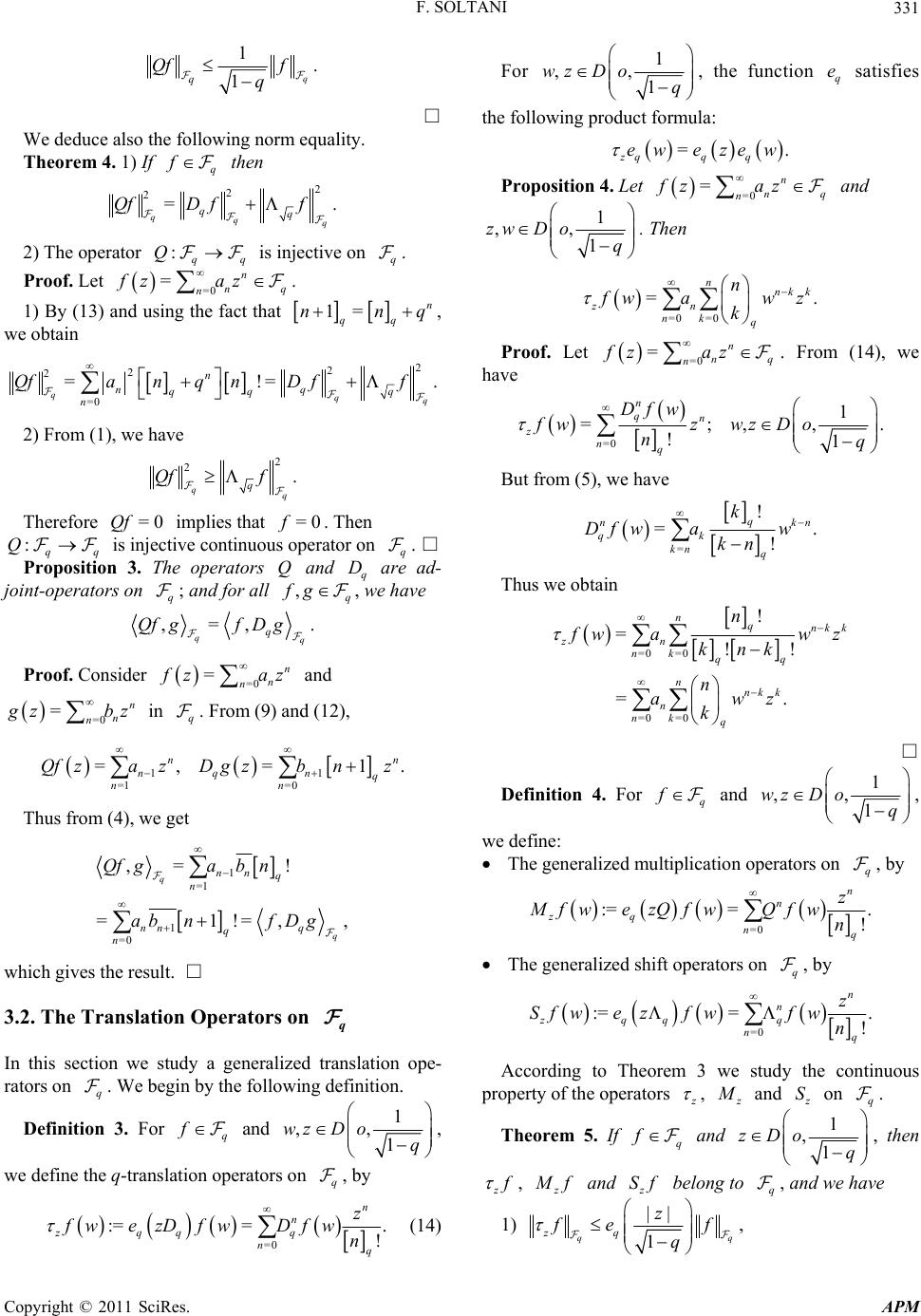 F. SOLTANI331 1. 1q q Qf f q □ We deduce also the following norm equality. Theorem 4. 1) If then q f 2 2 2=. qq q Qf f q q D f 2) The operator is injective on Proof. Let 1) By (13) and using the fact that :qq Q n q . =0 =nq n fz az . 1= n qq nn , q we obtain 2 =0 . qq nq q qq n QqD ff 2) From (1), we have 2 2 2=!= qn fann 2 .f 2 qq q Qf . Then ator on □ e operators ad- joint-ope rators on and for all e have Therefore =0Qf implies that f :qq Q is injective continuous op Propositi =0 er Q and q . re on 3. Th q D a q , w q ; ,fg ,=, qq q QfgfD g . Proof. Consider =0 =n n n f za z and =0 =n n n g zb z in q . From (9) and (12), . n =0 =Qf zz , =1 n azDgzbn 11 =1 nq n q nn Thus from (4), we get 1 =1 =0 ,=! = qnn q n n Qf gabn a n which gives the result. □ 3.2. The Translation Operators on In this section we study a generalized translation ope- rators on We begin by the following definition. Definition 3. For and 11 !=,, q nn q q bf Dg q q . q f1 ,, 1 wzD oq , perators on , by we define the q-translation oq =0 :== n zq q q n fw e zDfwDfn For 1 ,, 1 wz Doq , the function q e satisfies the following product formula: =. zqq q e w ew ze Proposi t ion 4. Let =0 =n nq n fz az and 1 ,, 1 zwD oq . Then =0 =. nnk k zn n n =0 kq f wa wz k Proof. Let =0 =n n n fz az q . From (14), we have =0 1 = . 1 q zn Df fw nq ; ,, ! nn q wzwzDo But from (5), we have = ! =. ! q nk qk kn q k Dfwaw kn n in Thus we obta =0 =0 . ! n q z w (14) =0 =0 n nk ! =!! =. nqnk k zn nk qq nnk k q n f wa wz knk n awz k □ Definition 4. For and 1 ,, 1 wzD oq q f , we defi The generalized multiplication operators on , by ne: q =0 := =. ! n n zq nq z Mfwe zQfwQfwn The generalized shift operators on , by q =0 zq n := =. ! n n q q q z Sf wezf wf wn g to Theorem 3 we study the continuous Accordin oprperty of the operators z , z M and z S on q . and 1 ,1 zDoq Theorem 5. If q f en , th z f ,z M f and belong to and we have 1) z Sf q , ||z 1 qq zq f ef q , Copyright © 2011 SciRes. APM 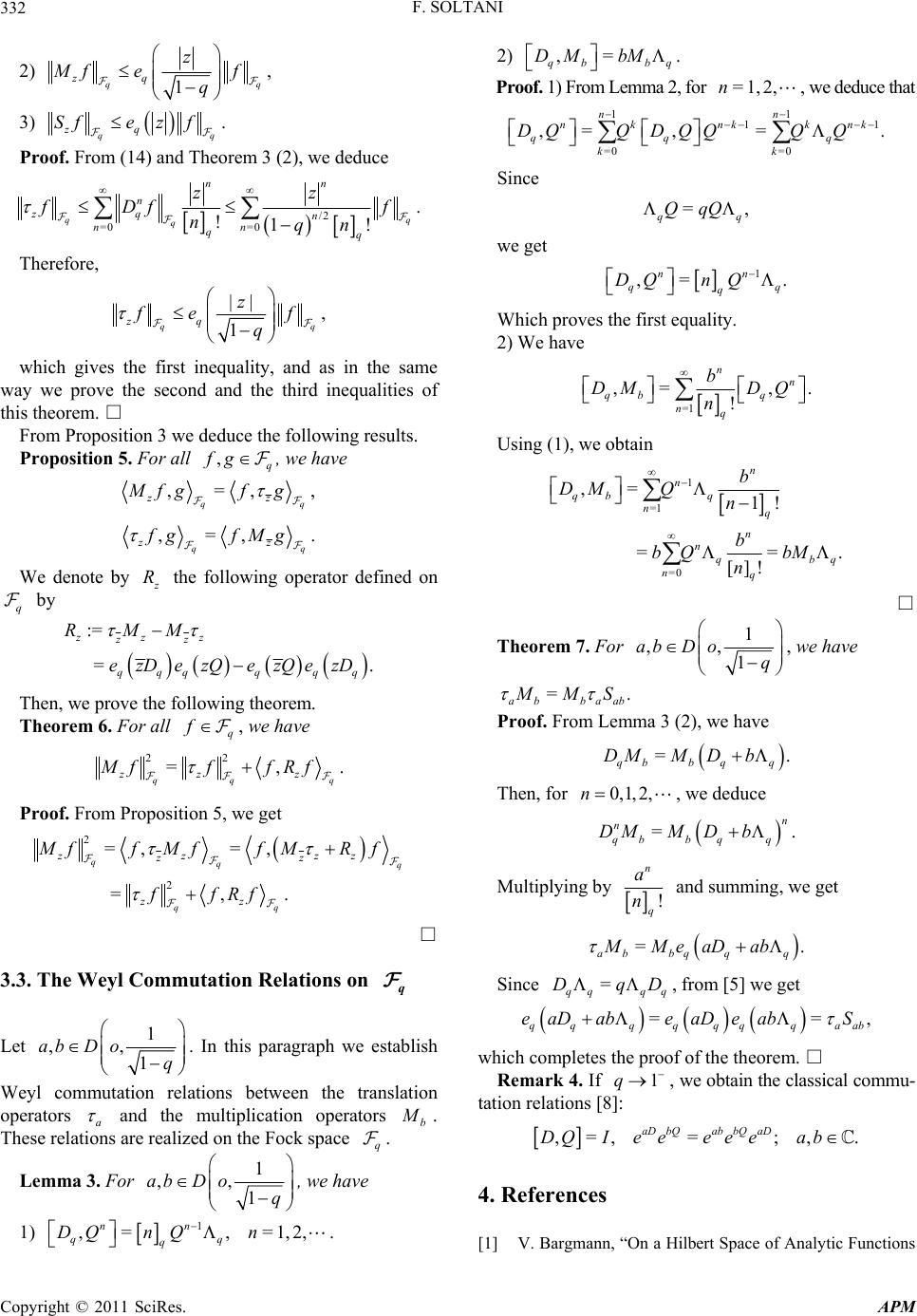 F. SOLTANI 332 2) 1 qq zq z M fef q , 3) qq zq Sfe zf . Proof. From (14) and Tore3 (2), we deduc hem e /2 qq zq n zz f f fore, =0 =0 !1! q nn qq nqn. nn n fD There || , 1 qq zq z fef q which gives the first inequality, and as in the same way we prove the second and the third inequalities of this theorem. □ s. Proposi t ion 5. For all From Proposition 3 we deduce the following result ,q fg , we have ,=, qq zz Mfgf g , ,=, qq zz fg fMg . We denote by z R the following opera defined on by tor q := =. zzz zz qqqq qq RMM ezDezQ ezQezD Then, we prove the following theorem. Theorem 6. For all f have q , we 22 =, qq zz z Mff fRf . q Proof. From Proposition 5, we get 2=,=, qqq zz zz z 2 =,. qq z zz M ffMffMRf ff Rf □ 3.s on Let 3. The Weyl Commutation Relationq 1 ,, 1 abD oq . In this paragraph e establish Wn the translation operators w eyl commutation relations betwee a and the multiplication operators b M . These relations are realized on the Fock space Lemma 3. For q . 1 ,, 1 abD oq , we have 1) 1 ,=,= 1,2, nn qq q DQ nQn . 2) ,= qb bq DM bM . Proof. 1) From Lemma 2, for we deduce that =1,2,n, 11 ,= ,= nn nk qq q DQQ DQQQQ 11 . nk knk =0 =0 kk Since =, qq QqQ we get 1 ,= nn qq q DQ nQ . Which proves the first equality. e have 2) W =1 ,= , ! nn qb q nq .DM DQ n Using (1), we obtain b 1 =1 =0 ,= 1! ==. []! n n qb q nq n nqb nq b DMQ n b bQb q n □ Theorem 7. For M 1 ,, 1 abD oq , we have =. ab baab M MS Proof. From Lemma 3 (2), we have Then, for =. qbbqq DMM Db 0,1, 2,n , we deduce Multiplying by =. n n qbbqq DMM Db ! n q a n and summing, we get Since D =. abbq qq MMeaDab =Dq qq qq , from [5] we get == qqq qqqq aab eaD abeaDeabS , which completes the proof of the theorem. □ . If Remark 41q , we obtain the classical commu- tation relations [8]: ,=,=;, aD bQab bQ aD DQIeee eeab . 4. References [1] V. Bargmann, “On a Hilbert Space of Analytic Functions Copyright © 2011 SciRes. APM 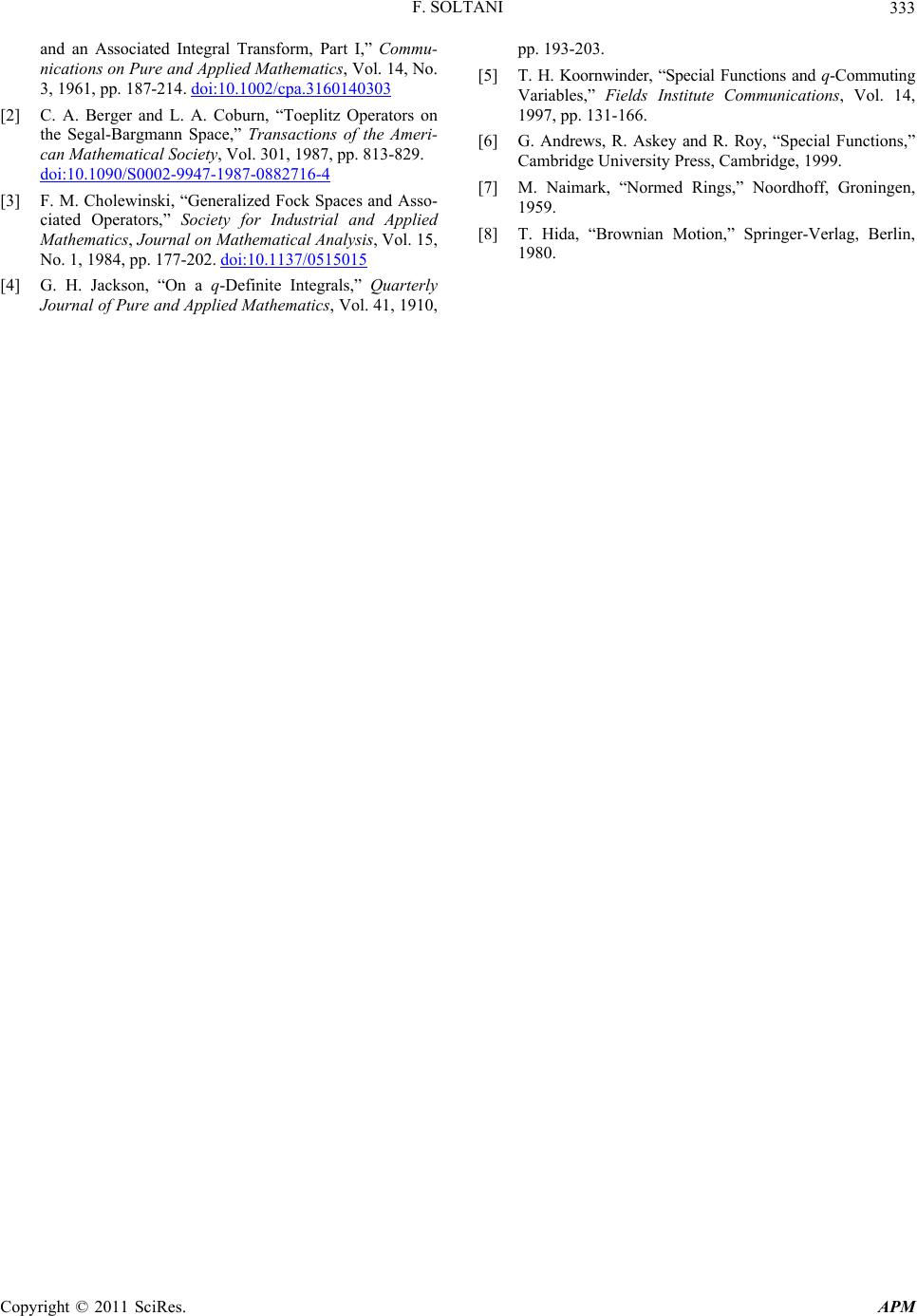 F. SOLTANI Copyright © 2011 SciRes. APM 333 an Associated Intart I,” Commu- on Pure and Applied Mathematics, Vol. 14, No. 3, 1961, pp. 187-214. doi:10.1002/cpa.3160140303 and egral Transform, P nications [2] C. A. Berger and L. A. Coburn, “Toeplitz O rgmann S perators on -9947-1987-0882716-4 the Segal-Bapace,” Transactions of the Ameri- can Mathematical Society, Vol. 301, 1987, pp. 813-829. doi:10.1090/S0002 [3] F. M. Cholewinski, “Generalized Fock Spaces and Asso- ciated Operators,” Society for Industrial and Applied Mathematics, Journal on Mathematical Analysis, Vol. 15, p. 177-202. doi:10.1137/0515015 No. 1, 1984, p ] G. H. Jackson, “On a q-Definite Integrals,” Quarterly nctions,” [4 Journal of Pure and Applied Mathematics, Vol. 41, 1910, pp. 193-203. [5] T. H. Koornwinder, “Special Functions and q-Commuting Variables,” Fields Institute Communications, Vol. 14, 1997, pp. 131-166. [6] G. Andrews, R. Askey and R. Roy, “Special Fu Cambridge University Press, Cambridge, 1999. [7] M. Naimark, “Normed Rings,” Noordhoff, Groningen, 1959. [8] T. Hida, “Brownian Motion,” Springer-Verlag, Berlin, 1980. |

